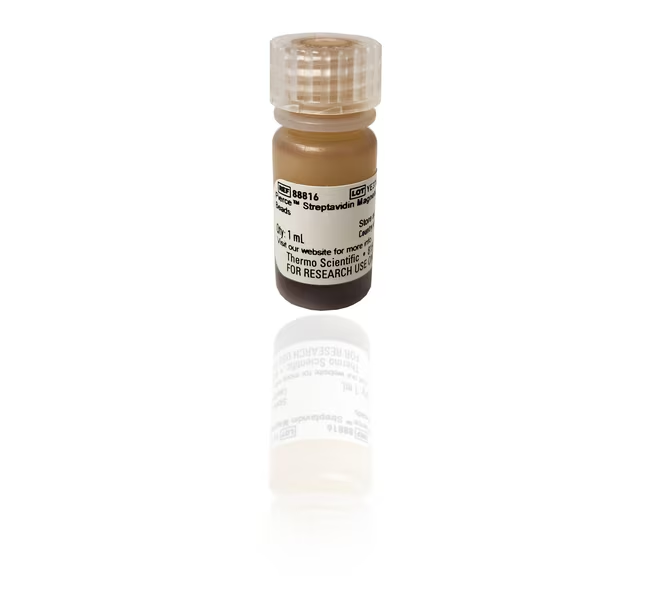
Thermo Scientific Pierce Streptavidin Magnetic Beads accelerate throughput for automated magnetic purification of biotinylated molecules.
Features of Streptavidin Magnetic Beads:
• High-performance beads—non-aggregating, pre-blocked, iron oxide, superparamagnetic microparticles provide exceptional uniformity for automated HTS and manual applications alike
• Stable immobilization chemistry—streptavidin is immobilized using leach-resistant chemistry
• High capacity—superior quality beads with high binding capacity provide rapid and efficient biomolecule purification from complex samples
• Low non-specific binding—stable, pre-blocked beads provide clean purification products (e.g., antigen eluted in IP with biotinylated antibody) that are compatible with mass spectrometry analysis and other downstream analyses
• Superior performance—nearly three times higher binding capacity than typical beads from other suppliers, allowing the use of smaller amounts per experiment
Applications:
• Immunoprecipitate antigens (using biotinylated antibodies) from a wide variety of sources
• Co-immunoprecipitate interaction complexes using biotinylated antibodies
• Capture protein-protein interactions in pull-down assays using biotinylated 'bait' proteins
• Isolate biotin-labeled DNA-protein complexes from cell or tissue extracts
• Capture single-stranded biotinylated DNA oligos
• Isolate biotinylated PCR products
These streptavidin magnetic beads are validated and optimized for use with high-throughput magnetic platforms, such as the Thermo Scientific KingFisher 96 and KingFisher Flex Instruments, but the beads also enable premium performance for simple benchtop applications using an appropriate magnetic stand. The iron oxide, super-paramagnetic particles offer superior performance (high capacity and low nonspecific binding) compared with other commercial magnetic beads.
Pierce Streptavidin Magnetic Beads use a recombinant form of streptavidin with a mass of 53kDa and a near-neutral isoelectric point (pI). The protein is a tetramer having four biotin-binding sites. Unlike avidin, streptavidin has no carbohydrate groups, resulting in low nonspecific binding. The high-affinity interaction between streptavidin and biotin cannot be dissociated efficiently except with very harsh conditions, such as boiling in sample loading buffer for SDS-PAGE or 8M guanidine·HCl, pH 1.5. Consequently, it is often possible to elute binding partners in an interaction complex without also eluting the biotinylated component.
| Code | Description |
|---|---|
| 88816 | Catalog Number: 88816 |
| 88817 | Catalog Number: 88817 |

